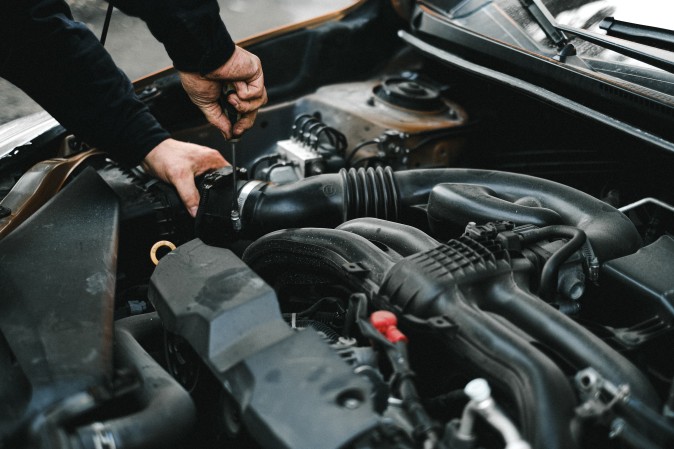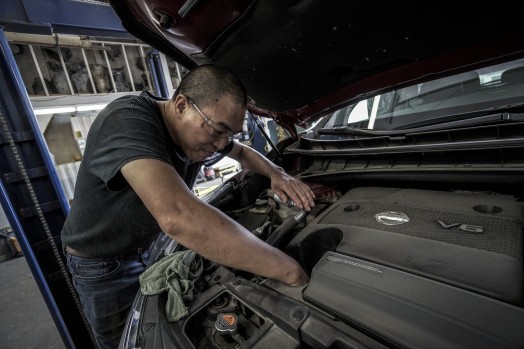Automobiles are intricate devices that frequently display enigmatic behaviors that leave their owners perplexed. Even while coolant and oil spills are frequent worries, seeing water collected under your car can be just as confusing. Knowing the cause of your car’s leaks is essential to keeping it working and in good condition. The first step in solving any leak, whether it is from simple dampness or more complicated problems with the cooling or air conditioning systems, is locating its source.
Importance of addressing water leaks promptly:
It is important to fix water leaks in your car as soon as possible for several reasons.
- Preventing Interior Damage: Water leaks can cause your car’s interior to get moist, which can lead to the growth of Mould and mildew. These can harm the electronics, carpets, and interior upholstery of your automobile in addition to producing offensive odors.
- Avoiding Electrical Problems: Electrical failures can result from water incursion into delicate electronic components. Your car’s ignition, lighting, entertainment system, and even safety equipment like airbags may all be impacted by this.

- Maintaining Structural Integrity: Extended exposure to water might cause your car’s structural integrity to deteriorate. Metal parts are susceptible to rust, which can cause corrosion and jeopardize your car’s safety.
- Preventing Health Risks: If you or any of your passengers have allergies or respiratory problems, Mould and mildew growth in your vehicle can be harmful to your health. Water leaks should be fixed as soon as possible to keep the interior of the car healthy.
- Ensuring Safety: If water leaks damage parts like the windscreen or glass, it can also impair your vision. Leaks should be fixed as soon as possible to preserve unobstructed vision while driving and protect your safety.
Understanding the Source:
It is critical to identify the source of your car’s water leaks before taking any action. When determining the source of the water, keep the following points in mind:
- Differentiating Water from Other Fluids: It is critical to verify that the fluid is water and not coolant, oil, or another fluid before identifying the leak’s origin. While coolant leaks might be colored and have a pleasant smell, water leaks are typically transparent and odorless.
- Common Areas of Accumulation: Water can collect in your car’s floors, trunk, undercarriage, and engine compartment, among other places. Determining the precise position of the water buildup can aid in reducing the number of potential leak sources.
- Type of Water: Take note of the water’s properties, including its color and consistency. While colored or oily water may suggest an oil or coolant leak, clear water may signify condensation or rainwater.
- Air Conditioning System: The air conditioning system in autos is one typical place where water leaks occur. The HVAC unit’s evaporator coil produces condensation and the water that results should drain out of a tube underneath the vehicle. The interior of the car could seep water if this drain tube gets damaged or clogged.
- Coolant System: Water leaks into the car can also occur via leaks in the heater core, hoses, or radiator. Coolant leaks can look greasy or colored, and they frequently smell sweet.
- Rainwater Infiltration: Rainwater can enter an automobile due to damaged window seals, weather stripping, or seals, particularly when there is a lot of rain if the car is parked on an incline.
- Sunroof or Moonroof Drains: Blocked drain channels can lead to water overflow and interior leakage if your automobile has a sunroof or moonroof. Over time, debris can jam these drains, making effective draining impossible.
- Heater Core: Water seeping into the car’s interior can potentially be the result of a leaky heater core. When the heater is on, there can be a pleasant scent and windscreen misting in addition to this.
Causes of Water Leaks:
There are several reasons why water leaks occur in cars, and each one needs to be fixed differently. The following are some typical reasons why cars leak water:
- Condensation: In cars, condensation is a normal occurrence, particularly when the air conditioning is on. Water can, however, build up inside the car due to excessive condensation or poor drainage.
- Air Conditioning System: Condensation is created when the air conditioning system cools the air. There should be a designated drain tube for this water to exit the car. Water may build up and leak into the car’s interior if the drain line gets disconnected or obstructed.
- Coolant System: Coolant may seep out of leaks in the heater core, pipes, or radiator and combine with water. Coolant leaks might appear as colored or greasy fluid and are frequently accompanied by a sweet scent.
- Rainwater Infiltration: Inadequate or damaged weather stripping around windows, doors, and the windscreen may let precipitation leak into the car’s interior. Rainwater leaks can also be caused by improperly sealed seams or sunroof/moonroof drains.
- Sunroof or Moonroof Drains: Water is removed from vehicles with sunroofs or moonroofs via drain tubes. Debris accumulation in these drains can obstruct effective drainage and result in water overflowing into the interior.
- Heater Core: Water may seep into the cabin’s interior due to a leaking heater core. A sweet smell and windscreen misting when the heater is on are symptoms.
- Washer Fluid Reservoir: Water leaks from a broken or fractured washer fluid reservoir can end up in the engine or on the ground underneath the car.

Signs and Symptoms:
Understanding the telltale signs and symptoms of water leaks in your car is essential for quickly identifying and resolving the problem. The following are typical signs that there might be a water leak in your car:
- Dampness or Wetness: Wetness or dampness inside the car is one of the most evident indicators of a water leak. Wet carpets, floor mats, chairs, or even headliners are examples of this.
- Moldy or Musty Odor: A buildup of water inside the car might encourage the growth of mildew and Mould. The presence of water leaks may be indicated by a persistent musty or moldy smell, particularly when the car’s interior is warm or damp.
- Water Stains: Visible water stains are frequently left behind by water leaks on interior surfaces such as headliners, door panels, carpets, and upholstery. These stains could show up as rings or discolored patches.
- Fogging or Moisture on Windows: Particularly in cold or humid weather, an excessive amount of moisture within the vehicle can cause fogging or condensation on the windows. Visibility may be hampered by fogging on the inside of the windows or windscreen.
- Puddles or Standing Water: You can see standing water or puddles in the spare Tyre well, trunk, or footwells if the water leaks are serious or persistent. The size of these puddles may change according to how much of a leak there is.
- Deterioration of Interior Materials: Carpets, upholstery, and insulation are examples of interior materials that might sustain harm from prolonged contact with water. Materials that are impacted by degradation may exhibit discoloration, sagging, or warping.
- Electrical Malfunctions: Water seeping into the electrical system of the car might cause electrical failures or malfunctions. Audio systems, interior lights, door locks, and power windows that do not work are symptoms.
- Visible Signs of Leakage: Sometimes it is possible to see where the water leak is coming from. Keep an eye out for indications of water seeping or dripping from window, sunroof, or moonroof seals, among other places.
- Unexplained Coolant Loss: If the coolant system is the source of the water leak, you might gradually see a drop in coolant levels in the absence of any obvious external leakage. Watch the coolant reservoir and look beneath the hood for any indications of leaks.
- Mold or Mildew Growth: Look for evidence of Mould or mildew growth in the car’s hard-to-reach places, such as the trunk, under the seats, or behind interior panels. These spaces are prone to moisture accumulation and, in the event of a leak, may serve as home to Mould colonies.
Prevention and Maintenance Tips:
Maintaining your car regularly and taking preventative action to defend against leak sources are essential to preventing water leaks. To help keep your car dry and leak-free, consider the following preventative and maintenance advice:
Inspect Seals and Weather Stripping: Examine the weather stripping and seals around windows, doors, and the windscreen regularly for indications of degradation or wear. To keep a watertight seal, replace any worn or broken seals.
- Keep Sunroof/Moonroof Drains Clear: To avoid obstructions, frequently check and clean the drain passages on any car with a sunroof or moonroof. To remove any debris from the drains, use either compressed air or a mild spray of water.
- Maintain Air Conditioning System: Verify that the condensate drainage system and the air conditioning system are operating as intended. If necessary, clear, or clean the drain tube to stop water from backing up into the car’s interior.
- Check Coolant System for Leaks: Check the coolant system frequently for leak indicators, such as coolant pools beneath the car or a gradual drop in coolant levels. To stop coolant from combining with water and creating internal leaks, leaks should be fixed as a way.
- Inspect Heater Core: Check the core periodically for corrosion or leakage. Inspect the automobile for any signs of moisture or coolant leaks, particularly when the heater is running. To stop water from getting inside, replace a leaky heater core.
- Keep Drains Clear: Make sure you routinely clean and remove any debris from drainage channels, which include those near the moonroof, sunroof, and windscreen. Clear away any debris, leaves, or other obstructions that can restrict drainage using a soft brush or compressed air help.
- Park in Sheltered Areas: Park your car in a covered or shaded spot whenever you can to reduce exposure to the elements and rain. Parking under trees or next to places that flood easily increases the chance of water leaks.
- Address Interior Spills Promptly: If you spill liquids inside the car, clean them up right away to keep the upholstery and carpets from getting wet. To eliminate extra moisture, use absorbent materials like towels or a wet/dry vacuum.
Frequently asked questions:
Is water leaking from an automobile normal?
Leaking water from an automobile is abnormal and frequently signifies an issue that needs to be fixed.
What’s causing the fluid leak under my car?
Your car’s fluid leak could be the result of a broken seal, a pierced radiator, or a broken hose.
Can I use my car even if it leaks?
If your car is leaking, it is not advised to drive it since this could cause more damage or safety hazards.
How much does a car’s air conditioning leak?
Condensation from an automobile’s air conditioning system may cause a small water leak.
Conclusion:
In conclusion, fixing water leaks in your car as soon as they occur is essential to preserving its integrity, safety, and worth. You can successfully detect and contain such leaks before they cause severe damage or pose a risk to public safety by being aware of the causes, indicators, and preventative steps mentioned. To keep your car, dry and leak-free and to guarantee years of comfortable, secure, and well-maintained driving, proactive maintenance is essential.

